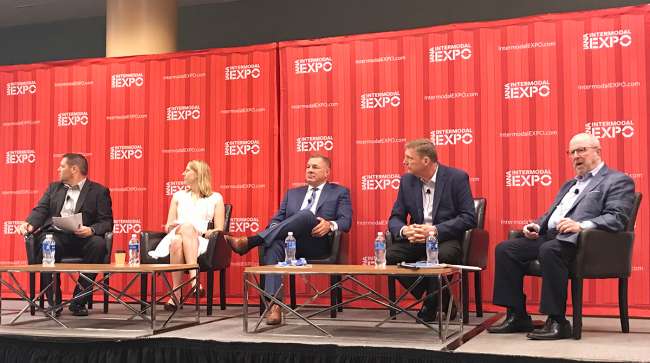Intermodal Works to Attract E-Commerce Shipments

[Stay on top of transportation news: Get TTNews in your inbox.]
LONG BEACH, Calif. — Speed and visibility are two of the most important factors that can help those within the supply chain capture e-commerce market share, and intermodal is finding ways to be more competitive in the space, according to speakers at IANA Intermodal Expo 2019 here.
Tom Williams, group vice president of consumer products for BNSF Railway, said e-commerce is supporting intermodal, but intermodal is going to have to have a better value proposition to attract the freight. That could include aligning with asset-based carriers to reduce friction. He added that the rails are working to leverage investments to improve service.
Williams said BNSF is continuing to triple-track and even quadruple-track some lines, and has six intermodal facilities it is expanding.
“As the coal business has declined, we’re looking at leveraging other opportunities,” he said.

Also at IANA
- Rail, Intermodal Providers Add Technology, Improve Operations to Boost Efficiency
- IMO 2020 Could Shift Freight Patterns, Increase Costs
- Independent Operator Rules Could Disrupt Drayage Operations
- Intermodal Industry Faces Uncertainties After Strong 2018
- Intermodal Works to Attract E-Commerce Shipments
- IANA Honors BNSF’s Steve Branscum, CCM’s Mike Wilson
David Ross, managing director of equity research, global transportation and logistics for Stifel, said with e-commerce, the focus is on the consumer and more, better, faster, which could pose a challenge for the intermodal sector.
“You can’t have faster supply chains without more airfreight, more truck movements and more warehouses near the consumer. This is only going to increase the cost of transportation overall,” Ross said, adding that supply chains will favor truck over intermodal and pay a 15% premium to get service.
Larry Gross, a consultant with Gross Transportation Consulting, said that as e-commerce grows, freight is becoming more dispersed, inventory is moving closer to the points of consumption, and intermodal is swimming against the tide.
“E-commerce is demanding higher speeds, more responsive systems, and inventory is being pushed out closer to the customer in order to have it positioned for quick response,” he said, “This is resulting in a more dispersed inventory picture with more secondary locations.”
At the same time, the precision scheduled railroading model means the intermodal network is being simplified with many secondary routes being eliminated, and even some terminals in secondary markets are being closed.
“Longer trains are being operated between major population centers. These trains, however, are running faster,” Gross said, adding that intermodal is improving its position for those portions of the market represented by the big city-to-city connections, but the opposite is true for secondary locations.
The railroads’ position is that PSR changes eventually will result in superior service in the remaining, key intermodal lanes, making the services more attractive to e-commerce participants, Gross said.
“However, in general, I would say that a ‘need for speed’ works against intermodal, which tends to be at least one day slower than truck, if not more,” he said.
A major means by which intermodal participates in e-commerce is through the movement of the trailers and containers of the parcel carriers, Gross explained. Much of this volume takes the form of trailer on flatcar, also called TOFC, rather than double-stack domestic container.
“As the railroads continue to de-emphasize TOFC and trim routes, only some of this volume will convert to container and the balance will stay in trailers, particularly 28-foot pups, but transition back to the highway,” Gross said.
Pat Casey, vice president of fleet management at TTX Co., a railcar pooling provider owned by nine railroads, told attendees that 41% of loads on conventional platforms are in containers, which is up lately from a long-term trend of 31%. Within trailer loading shares, 55% are in the less-than-truckload/parcel segment, 30% are in temperature controlled and 15% are dry van, Casey said.
When looking at trailer length, 20% are in 28-foot trailers, 8% are in midlength trailers and 72% are in 53-foot trailers.
WANT MORE NEWS? Listen to today's Daily Briefing
Todd Carter, vice president of domestic intermodal for BNSF Railway, said trailers constitute about 10% of its total units. He said UPS Inc. and parcel carriers are a big portion of the trailer traffic.
Ingrid Crafford, director of asset planning and optimization for Norfolk Southern Corp., said 8% of its overall business is in trailers, which is down from 10%.
Gross said there have been some advances in container participation in e-commerce, most recently with the purchase of intermodal domestic containers by Amazon.
No matter what mode shippers use, the growing role of e-commerce makes visibility more important, Stifel’s Ross said.
“Even if you have a slower part, like intermodal, it needs to be consistent and watched at all times,” he said.
As a result, railroads and intermodal providers have said they are investing in technology that provides greater visibility and data collection.




